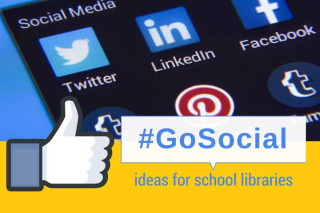- Your School Type
- Solutions
- Resources
- Blog
- Events
- More
- Contact Us
- Book a Demo
- Get a Quote

Social media channels offer exciting new possibilities for school librarians. There are so many ways you can use these free tools for connecting with colleagues and professional networks, promoting your library space and services, as well as learning and teaching.
The obvious advantage of social media is how easily it allows us to connect with others. Many school librarians work alone or with only a few colleagues and would benefit from more opportunities to interact with others in similar roles.
Whether you’re just starting out or you’re already a seasoned professional, there’s plenty to be gained from building relationships with your peers. In her blog post 5 Tips for New School Librarians, facilitator and educator Nikki D. Robertson recommends following popular industry hashtags and joining Twitter chats as great ways to expand your network. Nikki also recommends joining Facebook groups and shares a few of her own favourites, together with links to some education-focused chat rooms.
Library Media Specialist, author, and Future-Ready Librarians thought partner Laura Fleming details how having your own school library hashtag can help you create a community within and around your school library and expand your library’s reach beyond the school.
Much of the real value of connecting with peers comes from the ability to share conversations, content and advice.
As one respondent to the 2020 Softlink COVID-19 survey shared:
‘Facebook groups for librarians have been supportive and fantastic. I have learned much and gathered much - seek advice and resources from there.’
In his article, Why teachers are turning to Twitter, Dr Brendan Hyndman shares research which shows how educators are using Twitter to take part in global professional networks that allow them to find, share, and apply professional learning while combating isolation and supporting each other emotionally.
If you’d like to explore further, Education Services Australia provides a list of online courses and communities for educators.
As well as facilitating your own professional learning, social media can be a valuable tool to promote student learning and engagement. These channels have intrinsic appeal for today’s students and, thanks to their immediacy and global reach, they offer exciting new learning and real-world connection opportunities. Lucas Maxwell outlines a few of them in 5 ways social media can connect students with authors they love.
See also this collection of interesting ways to use Twitter in education.
Noticing how popular Snapchat had become among teenagers, educator Tara M. Martin came up with the idea of #BookSnaps – Snapping for Learning as a way of engaging students and encouraging them to read via a tool they were already using in daily life.
The Teens and Social media for Libraries Toolkit has plenty more suggestions and examples of ways for educators to use social media for hands-on, creative learning projects.
Social media provides another powerful channel for promoting your library and demonstrating its ongoing relevance within the school.
In 5 Reasons School Librarians Should Use Social Media on the Scholastic Education blog, Tamiko Brown suggests using social media to tell your library’s story by sharing key moments, such as the arrival of new books or setting up a new book display, action shots from makerspace activities, author visits or other happenings.
For examples of school library accounts that tell a fun and exciting story, see St Aidan’s Anglican Girls’ School and Carshalton High School for Girls on Twitter, and Hobsonville Point School libraries on Facebook.
Kathy Schrock’s Twitter for Teachers guide includes some great infographics on social media use in education and even a Dr Seuss-inspired guide to Twitter.
Christian Lauersen’s collection of library-related Twitter hashtags will help you find topical posts and threads to follow.
The United States Institute of Museum and Library Services have produced an infographic using research data that busts some of the most common myths about teenagers and social media.
The National Library of New Zealand has produced an excellent guide, Social media and the school library, which covers many aspects of social media for school libraries, including examples of successful social media campaigns, links to further resources and guidelines for creating a school social media policy.Is your school library already using social media? Which tools are you using and what has been their impact on your library? Connect with us @SoftlinkEdu on Twitter and share your story!
Editor’s note: This post was originally published April 2018 and has been updated for freshness, relevance, and accuracy in June 2020.